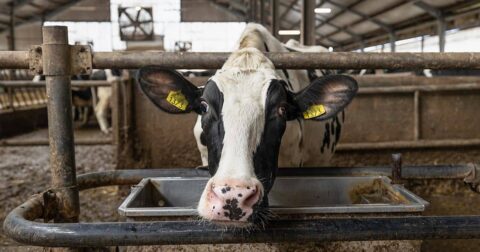Solutions
Miami Farmers Market Helps Fight Climate Pollution With Affordable Produce
Climate•6 min read
Reported
More than 40 million people depend on this vital U.S. waterway.


Words by Jennifer Mishler
A new report warns that a vital U.S. waterway depended upon by more than 40 million people is facing severe decline, as the Colorado River is being ‘drained dry.’ Agriculture is largely to blame for the “water crisis” in the western U.S., particularly industrial meat and crops raised to feed livestock, says Food and Water Watch, the environmental advocacy group responsible for the new findings.
Last year, a study found that the U.S. west was facing the worst drought it had seen in 1,200 years. Since then, the extremely dry conditions have modestly improved — especially after unusually heavy rains hit California — but the problem of water scarcity remains. And the stakes are high — Colorado River provides drinking water to seven U.S. states and two Mexican states, and two reservoirs fed by the Colorado River — Lake Mead and Lake Powell — play an important role in the nation’s power grid.
Despite being the largest drain on the river, factory farming hasn’t been held accountable. “Huge agribusinesses remain unphased by this crisis, continuing to abuse water supplies to feed animals on factory farms that, in turn, worsen the climate crisis and associated drought,” write the authors of the report. The Colorado River Basin is “Ground Zero” for the industry’s water and climate harms, according to the nonprofit, and 218 million gallons of water are used daily from the basin in order to feed and water 2.5 million dairy cows.
Alfalfa also requires a massive amount of water from the river. In 2022, over 2 trillion gallons were used for 2.7 million acres of land for alfalfa crops. For comparison, just .63 trillion represents all of the indoor household water needs for Basin residents, according to the report. And alfalfa is largely grown just to feed meat and dairy farm animals. In April, Vox explored which crops account for the most water from the Colorado River, concluding that 70 percent went to alfalfa, hay, grasses and corn ultimately used in cattle feed on beef and dairy farms. Other crops, such as soy, wheat and barley, may also be grown and used for feeding livestock in the region.
States along the river’s basin exceed the national average for irrigation water usage by 70 percent, finds Food and Water Watch, and this use is creating a vicious cycle. The report warns that factory farming is not only accelerating our climate crisis, but the industry will also need “more and more water” in the future thanks to extreme heat and other weather changes fueled by the climate crisis.
Research published in 2020 estimates that the Colorado River’s flow declines by over 9 percent with every degree Celsius that the Earth’s temperature rises, a loss that is too high to be countered by expected increases in precipitation.
Earlier this year, Politico called the uphill battle to reduce usage of the Colorado River “the first climate brawl” faced by President Joe Biden. In May, three river basin states agreed to, in total, reduce their use of water from the river by 13 percent, with Arizona, California and Nevada farmers and communities receiving $1.2 billion in Inflation Reduction Act funding in return for taking steps to conserve water.
Taking action to limit states’ use of the river is complicated, however. For example, Southern California’s Imperial Valley and its approximately 400 farms account for the largest percentage used, reports the Washington Post, and here there are farmers who “have some of the oldest legal rights to that water, dating back more than a century” — older than the Bureau of Reclamation, established in 1902 and now responsible for overseeing the use of the Colorado River.
Indigenous communities are greatly impacted by the river as well and, as the report points out, have inhabited the surrounding land since before the passing of federal and state laws. Despite their senior water rights in some cases, tribes have been largely left out of talks and decisions when it comes to the river. “This has led to a patchwork of rights across the basin, where some tribes have officially quantified water rights while others are still working to achieve them,” reads the report.
To Food and Water Watch, though, it is crucial that “a history of bad policy” is now corrected — and the agreement between these states and the Biden administration does not go far enough.
The agreement lasts through the year 2026 and is therefore “not a permanent solution,” write the authors of the report. “The proposal also does not cut nearly enough water to restore the Colorado River — states need to cut four times as much annually for the reservoirs to recover.” Food and Water Watch is calling for both state and federal regulation of water usage, along with aid for small-scale farmers to facilitate their transition to more sustainable practices.